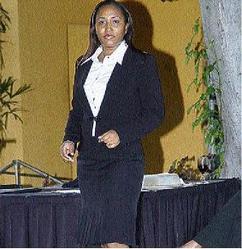Marigold Harding, Contributor

The right suit, with the right cut and a good fit, keeps you in step with others in the corporate environment. Adrienne, located in the lobby of the Hilton Kingston hotel, carries a variety that is perfect for that environment. - Winston Sill/Freelance Photographer
You asked for it and it's back - the popular and very informative series on how to behave, dress and live an exemplary life by international florist and etiquette consultant, Marigold Harding.
As an employer, you have the right to set the standards of the company's dress code. Clear policy on dress code can spare employees feelings.
People are judged by their actions (manners) and by their appearance (standards set by culture or corporate).
Dress code
Guidelines about what is acceptable or unacceptable. Enforcement is the key word. For instance, if someone breaks a rule, will they be sent home, fined or disciplined and if so, are you able to defend in court why that rule is necessary for the job?
When employees are allowed to become lax, later on it becomes difficult because standards are implied. You might hear the comment, "What's changed all of a sudden that I have to dress differently now?"
General guidelines
Write a general guideline in the policy manual. State the importance of the company image being established with clients.
Remember that employees are representatives of the company and are expected to dress professionally.
Thank them for their cooperation and remind them that clients could assume that their work is unprofessional and careless if their appearance gives that impression.
Make it clear that dress code relates to customer expectations and is much more than an in-house arbitrary standard.
Emphasise the importance of the company's image as well as their own image and how it relates to career advancement.
Compliment employees when they dress professionally. Setting dress codes requires sensitivity.
Some things about clothing never change. First, people judge you by your clothes, a vital ingredient in making a good first impression. Dressing as your peers do but with more style often gives you an advantage no matter where you work.
Organisation Style
Every organisation has a style and you conform to belong.
Understanding the code and how to shine within it, not only lets you express your individuality but sends a message that you are forward looking and confident.
Suit, Style and Cut
Suit cuts fall into three categories:
American Cut - Classic medium contour, centrevented or unvented jacket with a natural shoulder. Pants have a moderate or straight line.
Italian Cut - Jacket has a narrow shape with a shoulder that is fuller or more rounded with a slightly fuller chest. It is unvented in the back. Pants are slightly wider.
British Cut - Jacket slightly square, stronger in the shoulders and more shapes at the waist. Jacket frequently vented. Pants are slimmer than the Italian and American style.
All three cuts come in two or three-button styles. When wearing a three button, you can button the top two or just the top.
Fabrics
Wool, cotton or either of these blended with the new micro fabrics, synthetic fabrics.
Wool - has the ability to stretch and still keep its shape, and the ability to breathe keeps you warmer in the winter and cooler in the summer.
Woolen fabrics are made from loosely twisted fuzzier yarn and go by the name of tweed, flannel and melton.
Worsted wool is yarn twisted more tightly, 13 times and is the basis of gabardine and crepe.
Wool blends are popular because they unravel less.
Cotton - In the summer, cotton and linen are more comfortable. But linen will look as if you slept in it only after a few hours. A light-weight wool wrinkles less and is actually cooler than cotton for summer.
Microfibres - Synthetic fibres made from petroleum-based chemicals. From the time nylon was introduced in 1938, the point of synthetics was to reduce the wrinkles (wash and wear).
Colours
Black, navy blue and grey have become the business standards. Pin stripes are favourable breaks from the monotony.
Sports jacket - a jacket without matching pants.
Blazer -falls between the three-piece jacket and the sports jacket. Navy and black are colours of choice worn with slacks that have a colour of contrast.

